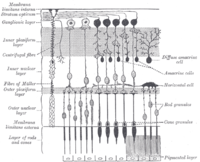
Photo from wikipedia
The retina is part of the central nervous system, its analysis may provide an idea of the health and functionality, not only of the retina, but also of the entire… Click to show full abstract
The retina is part of the central nervous system, its analysis may provide an idea of the health and functionality, not only of the retina, but also of the entire central nervous system, as has been shown in Alzheimer’s or Parkinson’s diseases. Within the retina, the ganglion cells (RGC) are the neurons in charge of processing and sending light information to higher brain centers. Diverse insults and pathological states cause degeneration of RGC, leading to irreversible blindness or impaired vision. RGCs are the measurable endpoints in current research into experimental therapies and diagnosis in multiple ocular pathologies, like glaucoma. RGC subtype classifications are based on morphological, functional, genetical, and immunohistochemical aspects. Although great efforts are being made, there is still no classification accepted by consensus. Moreover, it has been observed that each RGC subtype has a different susceptibility to injury. Characterizing these subtypes together with cell death pathway identification will help to understand the degenerative process in the different injury and pathological models, and therefore prevent it. Here we review the known RGC subtypes, as well as the diagnostic techniques, probes, and biomarkers for programmed and unprogrammed cell death in RGC.
Journal Title: International Journal of Molecular Sciences
Year Published: 2022
Link to full text (if available)
Share on Social Media: Sign Up to like & get
recommendations!